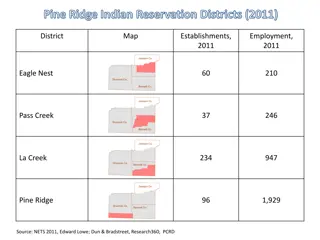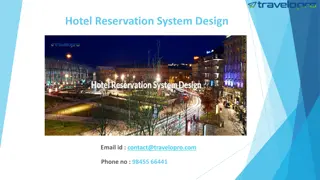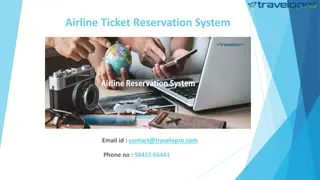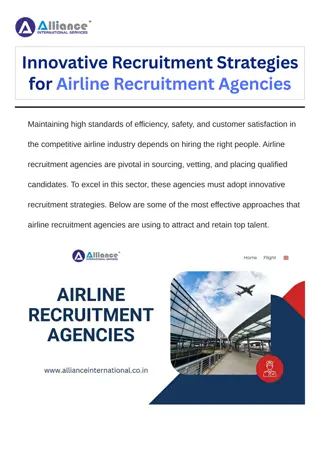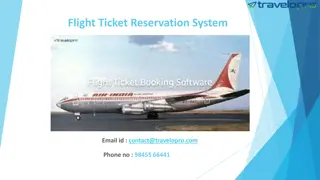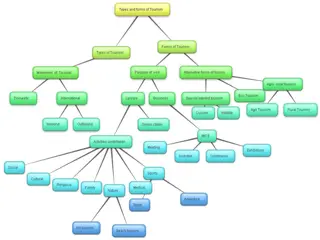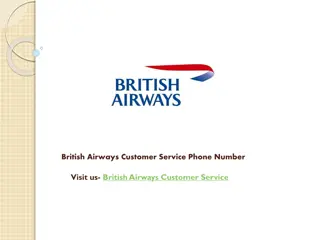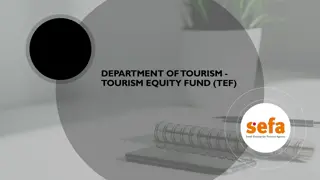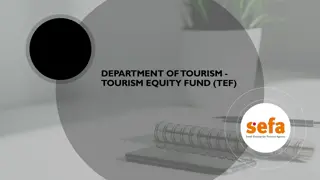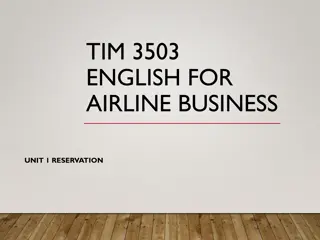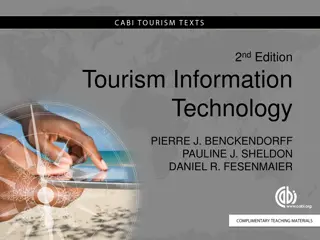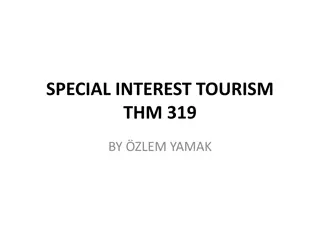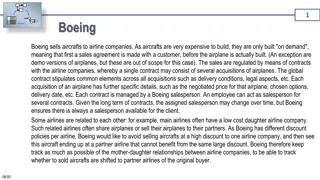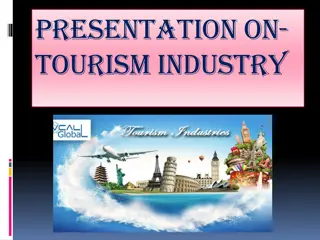Airline Information Technology and Reservation Systems in Tourism
Exploring the intersection of technology and tourism, this content delves into the impact of Information Technology on airlines and travelers. From airline reservation systems to management decision-making and airport operations, discover key concepts, types of airlines, and essential IT systems used in the aviation industry.
Download Presentation

Please find below an Image/Link to download the presentation.
The content on the website is provided AS IS for your information and personal use only. It may not be sold, licensed, or shared on other websites without obtaining consent from the author. Download presentation by click this link. If you encounter any issues during the download, it is possible that the publisher has removed the file from their server.
E N D
Presentation Transcript
3rdEdition Tourism Information Technology PIERRE J. BENCKENDORFF ZHENG XIANG PAULINE J. SHELDON
Chapter 7 Aviation and Information Technology
Chapter 7 Learning Objectives After studying this chapter you should be able to: 1. Analyze the impact of IT on airlines and air travelers; 2. Explain how airline reservation systems work and how they connect with other information systems; 3. Understand how information systems support management decision making in airlines; 4. Examine how information technologies are used by airports to streamline the passenger experience; and 5. Evaluate the present and future information technology applications in airport operations.
Key Concepts Airline reservation system (ARS) Baggage handling system (BHS) Customer relationship system (CRS) Fare Quote System Flight Information Display Systems (FIDS) New Distribution Capability (NDC) Passenger name record (PNR) Passenger Service System (PSS) Revenue management system (RMS) Safety Management System (SMS) 4
Types of Airlines Low Cost Carriers (LCCs) Commercial airlines National flag carriers Charter airlines Types of Airlines 5
DECISION SUPPORT SYSTEMS AIRLINE RESERVATION SYSTEM DEPARTURE SYSTEMS Schedules & Availability Fleet Management Departure Control System Fare Quotes & Rules Schedule Optimization Gate Control Passenger Information Revenue Management Flight Dispatch Flight Operations Systems Ticketing MARKETING & CRM SYSTEMS TRAVEL INTERMEDIARIES GLOBAL DISTRIBUTION SYSTEM Direct Bookings Traditional Agents & OTAs Availability: Schedules Loyalty Programs Travel Management Companies Pricing: Fare Quotes & Rules Customer Service Tour Operators & Wholesalers Distribution: Booking & Ticketing TRAVELLERS IN FLIGHT TECHNOLOGIES Business & Leisure Entertainment Groups Communications Frequent Flyers Crew Support Systems FIGURE 7.1 Key IT systems used by airlines
Airline Reservation Systems Key Components: 1. Flight schedules and availability: availability display 2. Fare quotes and rules: fare quote system, fare rules, cabin classes, booking codes, fare basis code 3. Passenger information: passenger name record, record locator, special service requests 4. Electronic ticketing: e-ticket, boarding pass 7
Fleet Management Systems Fleet Maintenance Fleet Assignment Fleet Acquisition 8
Flight Scheduling Systems Scheduling systems must be able to handle: Strategic Goals Route Network Passenger Demand Aircraft Type Human Resources Environmental & Safety Regulations Airport Restrictions Contingency Planning 9
Revenue Management Systems (RMS) Capabilities Historical data Forecasting Modeling Decision support 10
Departure Control Systems (DCS) Capabilities Check in Boarding passes Seat Allocation Checked Baggage Load Control Passenger Identification Denied Boarding No shows and Standby Passengers Interline Connections Interoperability 11
In-flight Technologies Passengers In flight entertainment (IFE) system Geographic information system (GIS) Communication systems Crew Tablets Navigation, communication and flight logs Point-of-sale devices 12
ORIGIN AIRPORT TRANSIT DESTINATION Pre- arrival Pre- Check in Security Boarding Stopover Arrival boarding FIGURE 7.2 Stages of the Passenger Journey
Automated parking entry Automatic check in upon entry to terminal Parking availability Directions to terminal Notification & offer to book later flight if late FIGURE 7.3 Example of geofencing around an airport
Check in Options Online check-in Self-service kiosks Auto check in using geofencing and smartphones Check in counters 15
Key Steps in Security Scanning X-ray baggage screening Confirming traveler identity Body screening 16
Pre-boarding technologies Passengers Flight information display systems (FIDS) WiFi hotspots Recharge stations Mobile apps (e.g. airport navigation, GateGuru) Airports Business intelligence tools (passenger volumes, queues, dwell times) Point-of-sale (POS) systems Alerts and notifications 17
Arrival Immigration databases (e.g. No Fly List ) e-passports Scanners and cameras Passenger Identification: biometrics systems and future systems that will analyze walking gait, body language, heart rhythms or DNA profiles to identify passengers 18
Baggage and Cargo Handling Baggage handling systems (BHSs) Bag tags with optical bar codes Conveyer belts and robotic systems for sorting Baggage tracking systems (e.g. Bagtrac) Lost baggage systems (e.g. World Tracer) Self-service bag drops RFID bag tags and chips in luggage 19
Safety and Security Systems Communications Systems Navigation Systems Surveillance Systems Flight and Weather Information Systems 20
Environmental Management Systems (EMS) Noise Reduction Carbon Emission Reduction Energy Use Environmental Monitoring Technology Applications Water Quality 21
Discussion Questions 1. How will advances in smartphones and apps impact the marketing, distribution and delivery of aviation products? Throughout this chapter we have identified a number of applications allowing airlines and airports to track passengers by using signalling technologies such as NFC, RFID and BLE embedded in baggage tags and smartphones. What are the pros and cons of these applications? What privacy or ethical issues might arise? How can airlines and airports overcome these issues? Visit the FFP website for an airline you know. Look for information about redeeming and earning FF points (miles). List all the ways in which members can earn and redeem points. How does the technology on the website support the FFP? What improvements would you like to see? 2. 3. 22
Discussion Questions 4. By 2035 the global airline fleet is expected to be twice as large as in 2018 and by 2030 passenger numbers are expected to be double. How can information technology help airlines and airports cope with the challenges of this expected growth? Visit the website for Changi Airport in Singapore and browse through the pages about terminal facilities and services. Note down examples requiring use of information technology. What IT inspired airport services do you expect to see in ten years? How might airports and airlines use new technologies such as augmented reality, predictive analytics and the Internet of Things to streamline and improve the passenger experience? 5. 6. 23
Useful Websites SITA www.sita.aero Amadeus IT Solutions www.amadeus.com/airlineit Boeing www.boeing.com Changi Airport www.changiairport.com GateGuru www.gateguru.com Future Travel Experience www.futuretravelexperience.com SkyTrax www.airlinequality.com 24
Case Study SITA Soci t Internationale de T l communications A ronautiques Formed in 1949 by a consortium of European & British airlines Developed world s first business packet switching network Employs 4,700+ staff in over 200 countries Key solutions include: Sector Communications & Infrastructure Solutions Voice, data, messaging, mobility and desktop applications to support aircraft operations, air-ground communications, air traffic control and flight operations Passenger processing, baggage management and operations management Passenger management, reservations, e-commerce solutions, fare and ancillary services Border management, biometrics, risk assessment and identity verification Airports Airlines Government 25


